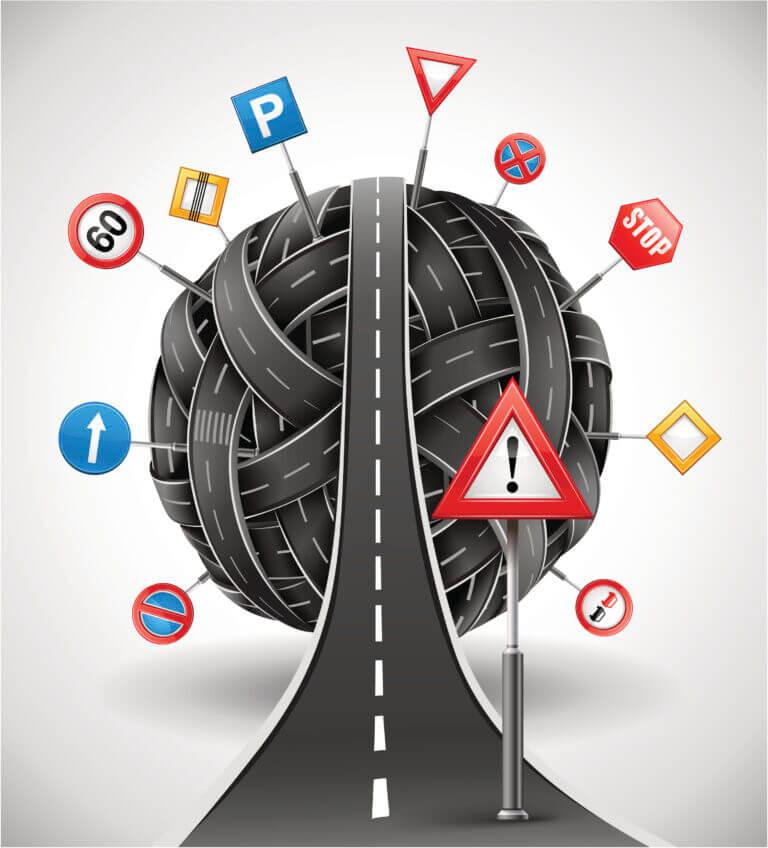In South Africa, where car theft remains a significant concern, protecting your valuable asset takes priority. While comprehensive insurance and security measures play a crucial role, car tracking devices have emerged as powerful allies in the fight against vehicle theft and the broader pursuit of vehicle security. But how do these devices work, and what factors can influence their performance? This blog delves into the intricate world of car tracking, unravelling the mysteries of accurate location data and highlighting the key elements that can impact its success.
Demystifying Car Tracking Technology: A Symbiotic Dance of GPS and Cellular Networks
Modern car tracking devices rely on a delicate ballet of two crucial technologies:
The Invisible Dance of Location: Unravelling the Mysteries of GPS and Cellular Networks
Forget magic spells and divining rods, the real-time tracking of your car rests on a complex yet elegant ballet of two technological powerhouses: the Global Positioning System (GPS) and cellular networks. Let’s dive into the intricacies of this invisible dance, where orbiting satellites whisper secrets to hidden antennas, culminating in the precise knowledge of your vehicle’s whereabouts.
The Celestial Choir: A Symphony of Satellites
Imagine a constellation of artificial stars, not shimmering with light, but with invisible radio signals. These are the GPS satellites, a web of over 30 orbiting Earth, constantly broadcasting precise information about their position and the time that signal was sent. Your car’s tracking device acts as a cosmic listener, catching these whispers from the heavens and using them to calculate its own location with remarkable accuracy. Even in remote areas far from bustling cities, these silent messengers ensure your car remains on the map.
The Whispering Bridge: Cellular Networks Carry the Secret Message
But knowing your location is only half the story. To make that knowledge actionable, your car’s tracking device needs a way to share it with the world. Here’s where cellular networks step in, acting as the invisible bridge between your vehicle and the central server. Just like your phone sends messages and calls, the device transmits the GPS-derived location data through the cellular network’s intricate labyrinth of towers and cables. This allows you to see your car’s position in real-time on a map, receive alerts about movement, and even remotely access other features like geofences or driving insights.
The Tango of Technology: GPS and Cellular Networks in Harmony
Think of GPS and cellular networks as partners in a tango. One provides the precise location information, while the other ensures its swift and reliable delivery. Together, they orchestrate a powerful performance, letting you stay connected to your car even when miles apart. This harmonious collaboration empowers you with enhanced security, convenience, and peace of mind, knowing your precious vehicle is never truly out of reach.
So, the next time you open your car tracking app and see your vehicle’s icon blinking on the map, remember the invisible dance playing out behind the scenes. It’s a testament to the remarkable collaboration between orbiting satellites and terrestrial networks, whispering and carrying secrets that ultimately bring your car’s location right to your fingertips.
Beyond the Dashboard: The Diverse Types of Car Tracking Devices
Not all car tracking devices are created equal. Each type offers varying functionalities and installation methods, catering to a spectrum of needs:
Choosing the Right Powerhouse: Navigating the Diverse World of Car Tracking Power Sources
The heart of any car tracking device is its power source. It’s the fuel that keeps the information flowing, ensuring you stay connected to your vehicle at all times. But just like choosing the right fuel for your car, selecting the optimal power source for your tracker depends on your individual needs and priorities. Let’s delve into the distinct advantages and drawbacks of each option, empowering you to make an informed decision.
1. Hardwired Trackers: Unwavering Reliability Plugged into the Core
For those who prioritize uninterrupted tracking and unwavering data availability, hardwired trackers offer the most reliable solution. These devices, as their name suggests, are directly connected to your car’s electrical system. This eliminates the need for batteries or external power sources, ensuring a continuous flow of location data regardless of battery levels or even a dead car battery. This makes them ideal for situations where consistent tracking is paramount, such as fleet management or high-risk vehicles. However, the convenience of constant power comes at the cost of professional installation. These devices require expert hands to integrate seamlessly into your car’s electrical system, a factor to consider if DIY projects aren’t your forte.
2. OBD Port Trackers: Plug-and-Play Simplicity on a Budget
For those seeking a simpler and more budget-friendly approach, OBD port trackers offer a compelling option. These devices, named after the On-Board Diagnostics port found in most modern cars, boast a user-friendly installation process. Simply plug them into the port, and you’re good to go. No wires, no fuss. This convenience also translates to affordability, making them a popular choice for budget-conscious individuals and those who might be intimidated by the prospect of hardwiring. However, their reliance on the car battery comes with a caveat. If your car battery dies, so does your tracking capability. Additionally, some advanced features might not be available through the OBD port, making them a slightly less feature-rich option compared to their hardwired counterparts.
3. Battery-powered Trackers: Untethered Freedom with a Charging Commitment
If portability and versatility are your top priorities, battery-powered trackers offer an attractive solution. These devices, equipped with rechargeable batteries, can be placed anywhere within your car or even discreetly used outside the vehicle. This makes them ideal for tracking trailers, motorcycles, or even valuable equipment. However, the freedom they offer comes with the responsibility of regular charging. Neglecting to keep the battery topped up can leave you with a tracking blind spot at the most inopportune moment. Additionally, the size and capacity of the battery can limit the device’s lifespan and tracking range compared to other options.
4. Solar-powered Trackers: Eco-Conscious Power from the Sun
For those who value sustainability and long-term solutions, solar-powered trackers offer an intriguing option. These devices harness the power of the sun to keep their batteries charged, eliminating the need for external power sources or even charging cables. This eco-friendly approach aligns with your environmental values while potentially reducing maintenance needs. However, their reliance on sunlight comes with inherent limitations. In regions with limited sunshine or during extended periods of overcast skies, the charging efficiency might drop, impacting the device’s performance. Additionally, their larger size and need for unobstructed sunlight exposure might limit their placement options within your vehicle.
Ultimately, the ideal power source for your car tracking device depends on your individual priorities and usage patterns. Carefully consider your need for reliability, ease of installation, budget, and desired level of portability to make an informed decision that keeps your car connected and your security enhanced.
Understanding the GPS Signal: The Heartbeat of Vehicle Tracking
Accurate location data hinges on a strong GPS signal. However, several factors can disrupt its smooth reception:
Navigating the Murky Waters of GPS: Environmental Roadblocks to Tracking Perfection
While car tracking technology shines as a beacon of security in the often-unpredictable world of vehicles, its accuracy isn’t immune to the whims of our planet. Just like a ship battling against stormy seas, your car’s GPS signal can encounter a variety of environmental roadblocks that can disrupt its ability to pinpoint your vehicle’s location with laser precision. Let’s dive into the murky waters of these potential hiccups, equipping you with the knowledge to navigate around them.
1. The Tyranny of Topography: When Hills, Foliage, and Skyscrapers Play Hide-and-Seek
Mother Nature doesn’t always play fair when it comes to GPS signals. Rolling hills, like mischievous giants, can block the celestial whispers from reaching your car’s antenna, resulting in location inaccuracies or, in extreme cases, temporary loss of connection. Dense foliage, a verdant curtain woven by trees and shrubs, can similarly dampen the signal, leaving you with a location that’s more “somewhere in this general area” than pinpoint precision. And let’s not forget the urban jungle: towering skyscrapers, acting as signal-hungry ogres, can create entire blind spots within their steel canyons, leaving you in the dark about your car’s whereabouts.
2. When the Heavens Cry: Rain, Snow, and Clouds Dampen the Signal’s Song
Even the sky can join the conspiracy against perfect GPS tracking. Heavy rain, like a celestial drumbeat, can scatter and weaken the signal, leading to location jitter and inaccuracies. Snowfall, a fluffy blanket muffling the whispers from above, can have a similar effect, especially for devices mounted on the exterior of your car. And let’s not forget the culprit that hides the sun: thick cloud cover. While not a complete signal blocker, it can act like a dimmer switch, reducing the signal strength and potentially impacting tracking performance.
3. Tunnels and Parking Garages: Metal Cages that Trap the Signal’s Freedom
The claustrophobic confines of tunnels and parking garages are the sworn enemies of GPS signals. These metal-encased labyrinths act like signal cages, completely blocking the celestial messages from reaching your car’s antenna. This creates frustrating blind spots, leaving you in the dark about your car’s location until you emerge back into the open sky.
Charting a Course through the Challenges: A Captain’s Guide to Clear Sailing
While these environmental factors can throw a wrench into the gears of perfect GPS tracking, there are ways to minimize their impact:
- Choose your device wisely: Some devices have improved antenna technology or signal correction algorithms that can handle challenging environments better.
- Parking matters: When possible, park in open areas with clear skies and minimal obstructions.
- Be aware of blind spots: Familiarize yourself with areas known for signal disruption and adjust your tracking expectations accordingly.
- Upgrade your app: Regularly check for app updates that might include improved signal processing or location estimation techniques.
By understanding these environmental challenges and taking proactive measures, you can ensure your car tracking system remains a reliable guardian in the ever-unpredictable journey of your vehicle. Remember, even when the skies frown and the terrain conspires, a little knowledge and strategic planning can keep you confidently navigating the sometimes-murky waters of GPS tracking.
The Unseen Enemy: Intentional Signal Disruption
Unfortunately, criminals aware of car tracking technology may attempt to jam the GPS signal using specialized devices. While uncommon, this threat highlights the importance of choosing a tracking system with additional security features like geofence alerts and remote immobilization, providing crucial safeguards even in situations of signal disruption.
Beyond Location: Unlocking the Wider Potential of Car Tracking
Modern car tracking systems go beyond simply pinpointing your vehicle’s whereabouts. They offer a wealth of features that enhance security, driving habits, and overall vehicle health:
- Real-time Location Tracking: Monitor your car’s location 24/7, offering immediate information and enhanced security, especially in case of theft or unauthorized use.
- Geofence Alerts: Set virtual boundaries around specific areas. Receive instant notifications when your car enters or exits these zones, providing early warning of potential unauthorized movement.
- Route Playback: Analyse past trips, understand driving patterns, and identify areas for improvement, potentially reducing risks and insurance premiums.
- Remote Immobilization: In the unfortunate event of theft, remotely disable your car’s engine, deterring further movement and significantly increasing the chances of recovery.
- Driving Habit Insights: Gain personalized feedback on your driving behaviour, such as speeding or harsh braking, allowing you to adjust your habits and promote safer driving.
- Maintenance Reminders: Receive timely notifications for scheduled maintenance based on your car’s mileage and service records, ensuring optimal performance and longevity.
- Emergency Assistance: Access emergency services and roadside assistance directly through the app, providing immediate support in case of accidents or breakdowns.
Investing in Security: Choosing the Right Car Tracking Solution
With a plethora of options available, selecting the perfect car tracking system for your needs in South Africa requires careful consideration:
- Individual Needs: Identify your primary security concerns and desired functionalities. Be it theft prevention, monitoring young drivers, or simply gaining enhanced control over your vehicle, understanding your needs helps guide your choice.
- Vehicle Compatibility: Ensure the device is compatible with your car model and features. Some require professional installation, while others offer simpler plug-and-play solutions.
- Budget: Compare prices of different devices and app subscriptions. Researching and determining a realistic budget prevents compromising on essential features due to unforeseen financial constraints.
- User-friendliness: Choose an app with an intuitive interface and user-friendly features.



